|
Leaves or Twigs - Chewed
|
| Insects |
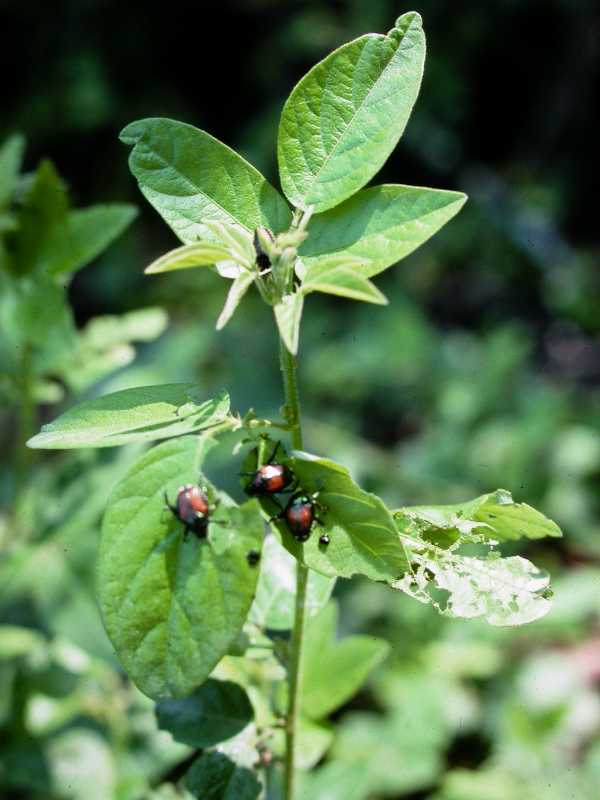 Japanese beetle
Japanese beetle |
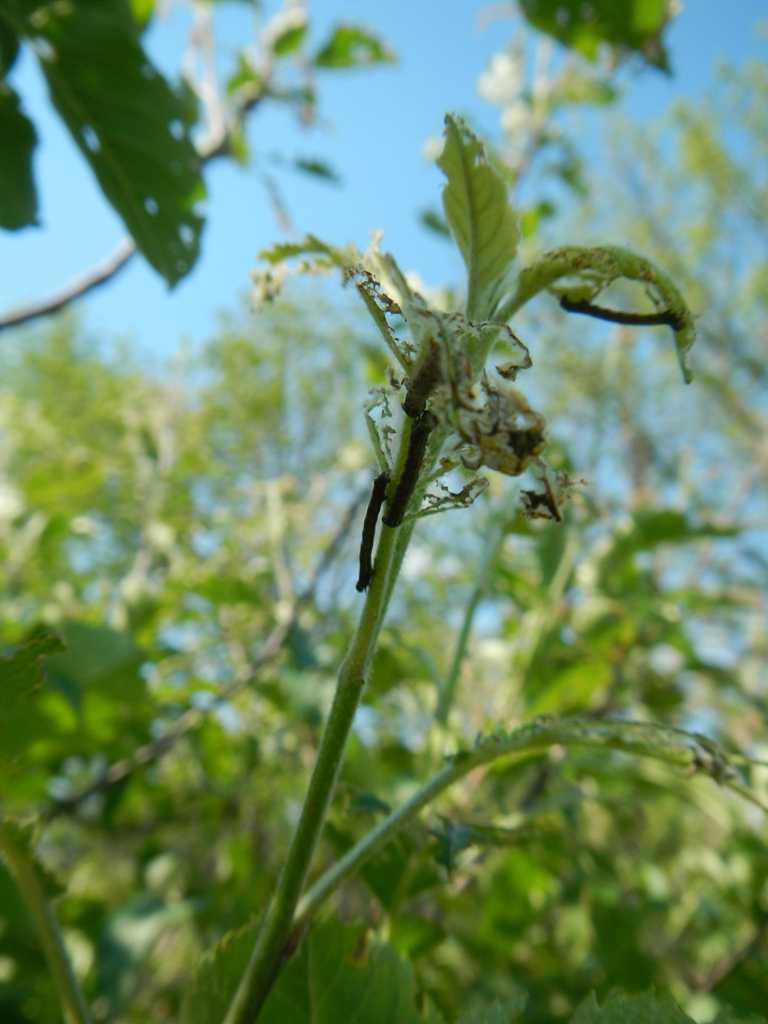 Caterpillars and Sawflies
Caterpillars and Sawflies |
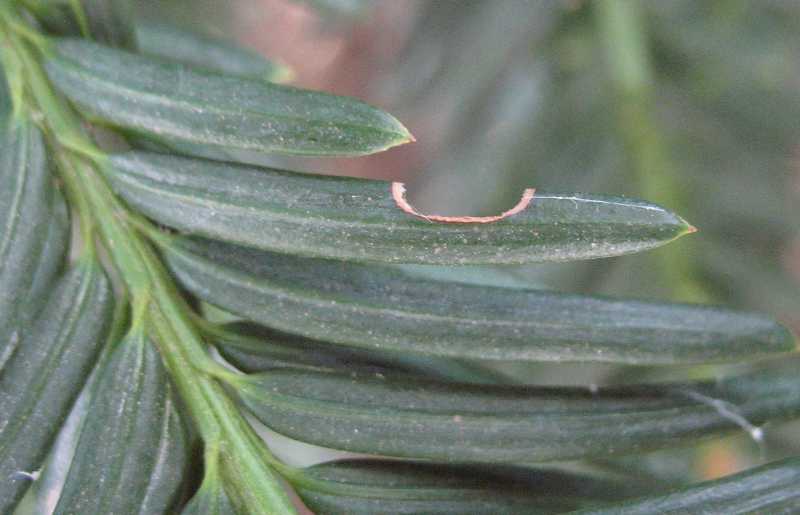 Weevils
Weevils |
Leaf-eating beetles including green beetle, elm leaf beetle and the Japanese beetle, damage plants by eating holes in leaves especially between the veins. They can give the leaf a lacy appearance. Severe damage can result in defoliation.
See:
Japanese beetle
Beetles – surface feeders
|
Spring and fall cankerworms commonly feed on tree leaves. In small numbers they do little damage but in heavy infestations they can cause defoliation.
See:
Cankerworms
Gypsy moth
Caterpillars – surface feeders
Sawflies – surface feeders
Web formers (below)
|
Some weevil adults and larvae feed in flowers, nuts or fruits, but others feed on leaves, stems and roots of woody plants. Some are destructive wood-borers. Close examination of roots, stems, fruit or seeds is necessary to locate the insects. Insects may not be visible during the daytime.
See:
Black vine weevil
Beetles - weevils |
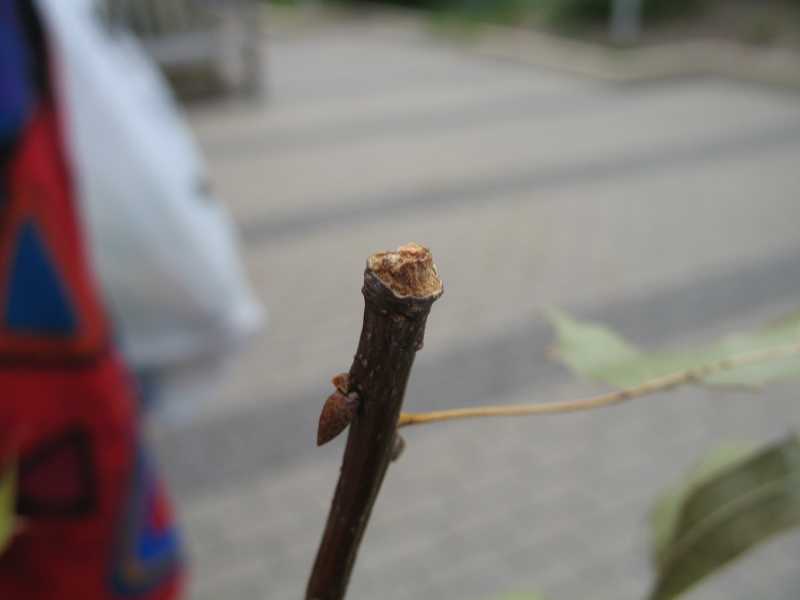 Twig girdler and pruner
Twig girdler and pruner |
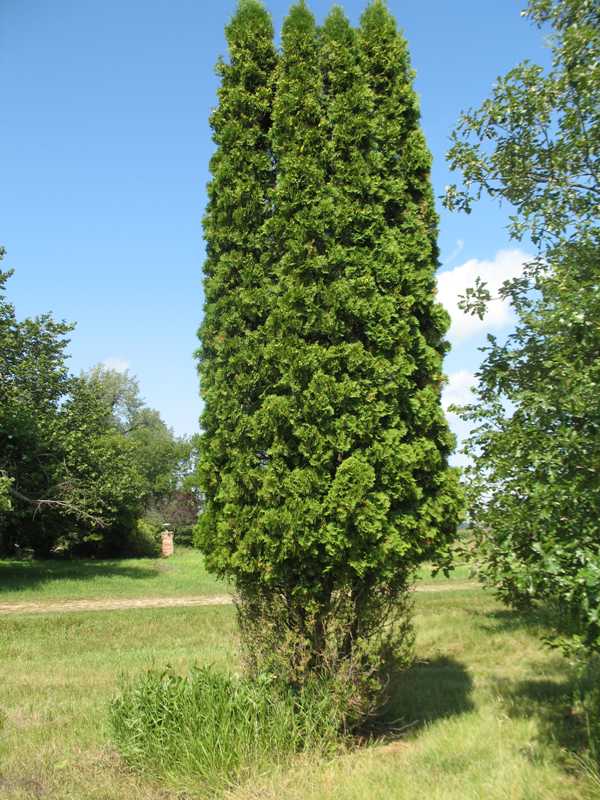 Other
Other |
|
Small twigs found on the ground can be the result of twig girdling beetles that chew the bark on young twigs and make them susceptible to breakage.
See:
Twig girdler and Twig pruner
|
See:
Deer
Rabbits
Leaf-cutter bees
Grasshoppers
Katydids
Hail damage
|
|
Leaves or Twigs - Spots, Discolored or with Noticeable Insects
|
| Insects |
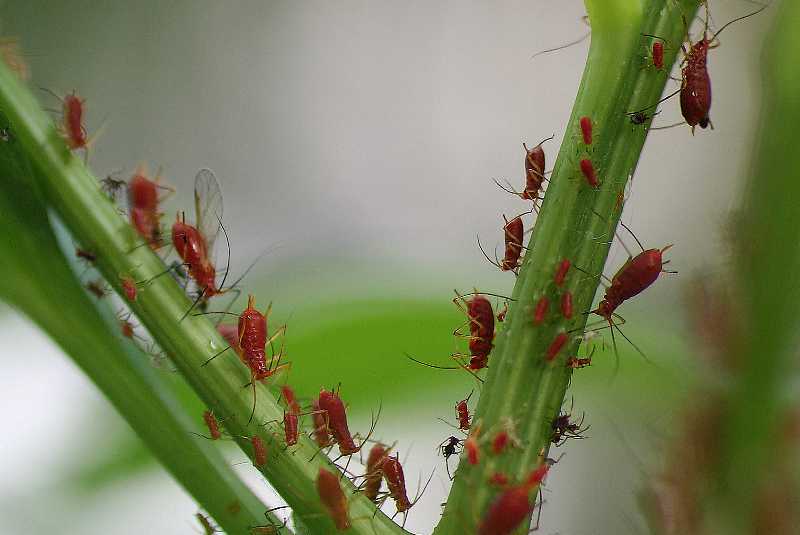 Aphids
Aphids |
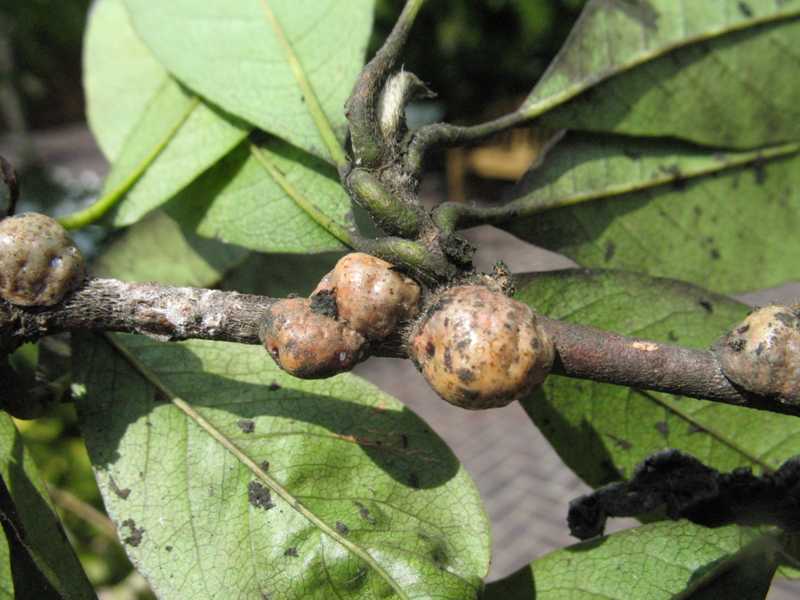 Scale
Scale |
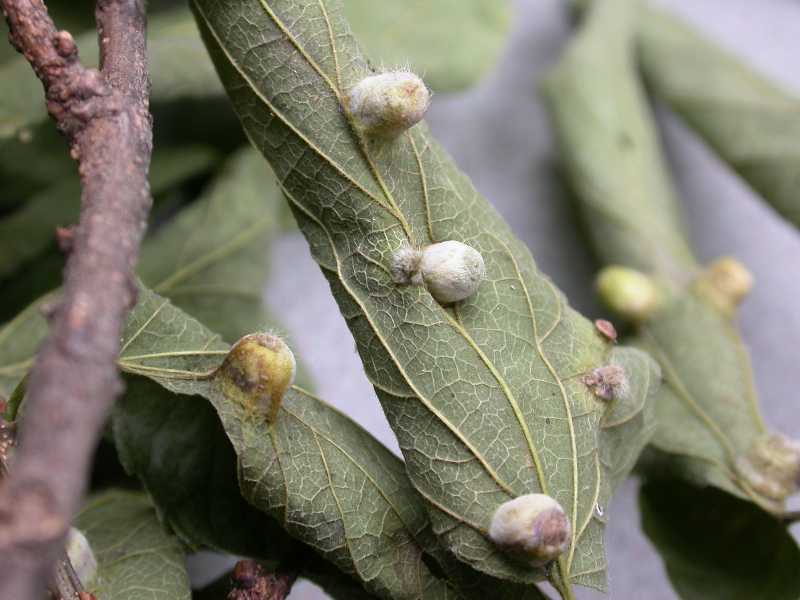 Galls
Galls |
Aphids are soft bodied, piercing-sucking insects that can be found in great numbers on young shoots or on the underside of leaves. Infestations can cause leaves to yellow and/or curl. Objects below the infested leaves and shoots, such as a car, can be covered with a shiny, sticky substance excreted by the insects.
See:
Aphids
Adelgids
Black mildew & Sooty mold
|
Many scale insects infest a wide variety of trees and shrubs. They form “bumps” on leaves and/or stems and the insects can be flicked off with a knife point. Leaves or other surfaces become shiny and sticky from the sugary excrement from the insects.
See:
Scale
Black mildew & Sooty mold
|
Galls are growths or swelling found on leaves, stems and/or roots. Some galls are caused by insects and other by disease organisms (see also Diseases below). In general, insect galls on leaves are of little concern as leaves have a short lifespan.
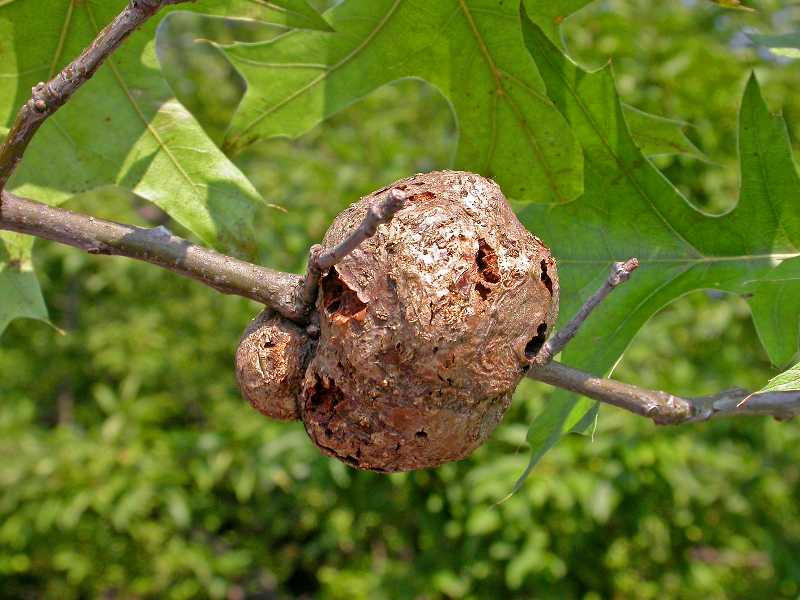
Galls on stems, however, such as gouty and horned oak gall, can be more serious as they can disrupt the vascular system in the stem and result in branch dieback beyond the gall. Insect galls can be difficult to control.
See:
Galls
Gouty and horned oak gall |
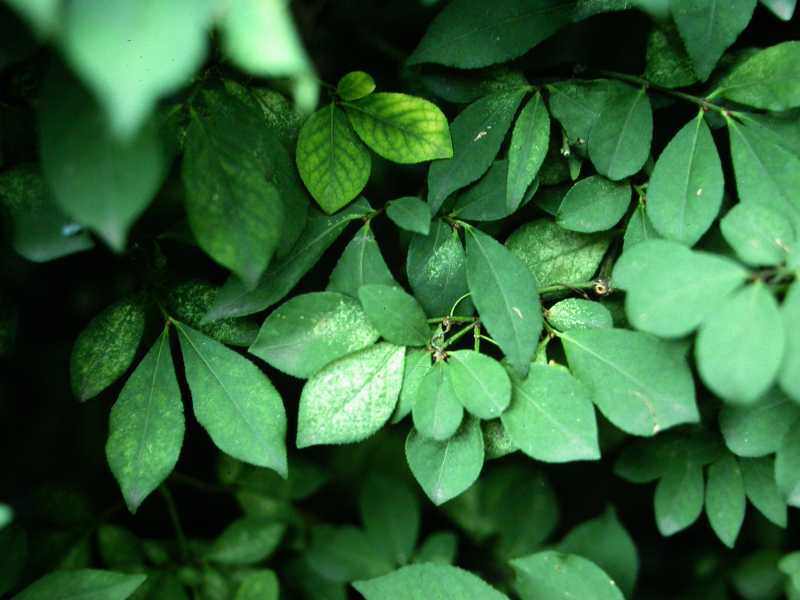 Spider mites
Spider mites
|
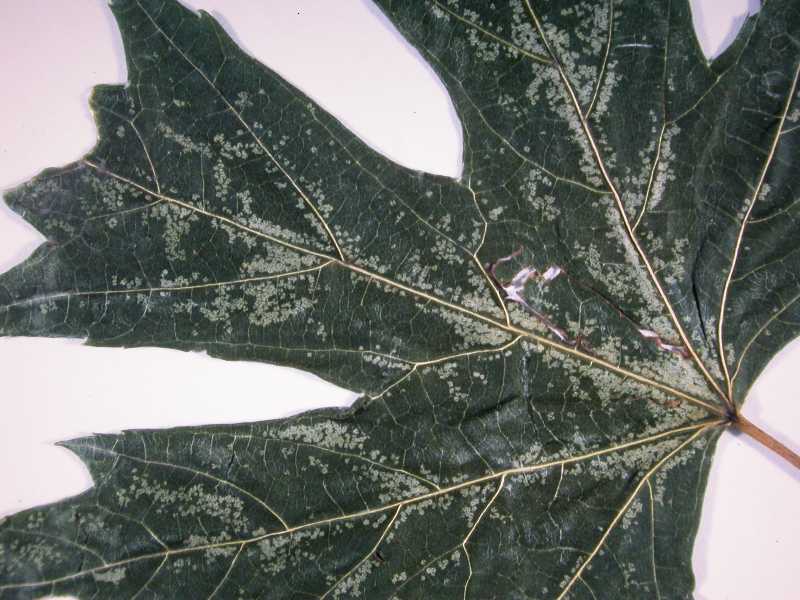 Leafhoppers
Leafhoppers |
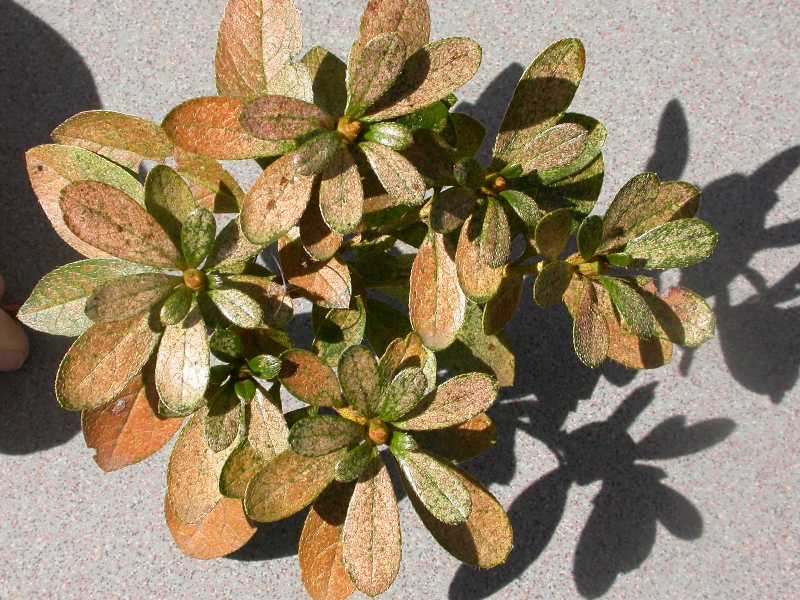 Lace bugs
Lace bugs |
Spider mites feed by sucking plant juices from the leaves. Dull, off-color or yellowing leaves often result. Adults are very small, the size of grains of pepper, and may be detected with the aid of a magnifying lens as tiny moving dots clustered on the undersurface of leaves. Fine webbing on leaves or in leaf axils or covering entire leaves may be found. Washing plants with a strong stream of water can help control the pest.
See:
Spider mites – outdoors
Spruce spider mite |
Dull, stippled, yellow and drying leaves are frequently the result of leafhopper feeding. These small, usually 1/8 to ¼ inch long insects with a pointed head have a characteristic hopping or sideways movement. They feed by sucking plant juices.
See:
Hoppers and Leafhoppers
|
Like other piercing-sucking insects lace bugs result in dull, bleached, yellow or drying leaves. A very common pest of azaleas, but also common on hawthorn, hackberry, sycamore and golden raintree. Early detection and control is required as several generations usually occur each year.
See:
Lace bugs
|
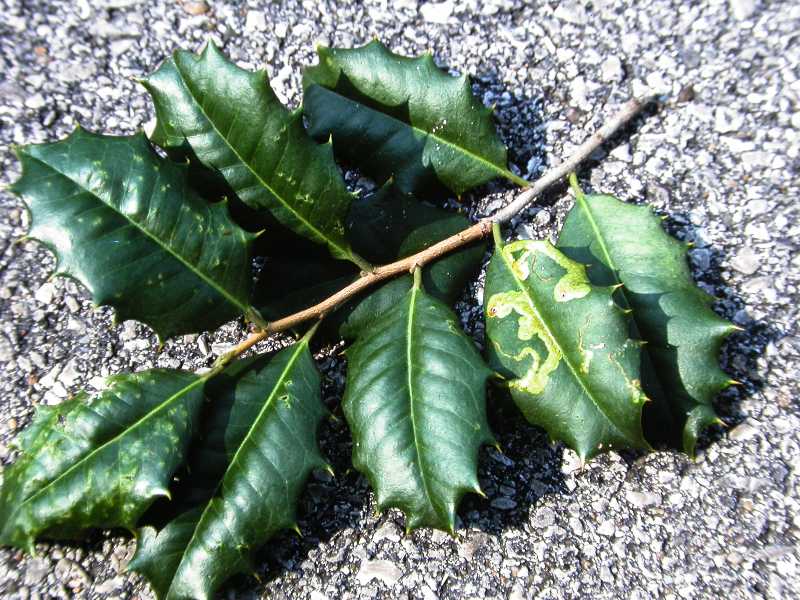 Leaf miners
Leaf miners |
|
|
“Trails” in leaves or spots that are hollow inside are often good signs of miners. Dissection of the leaf may reveal a burrowing insect inside the leaf.
See:
Flies – leaf and stem miners
|
|
|
| Diseases and Disorders |
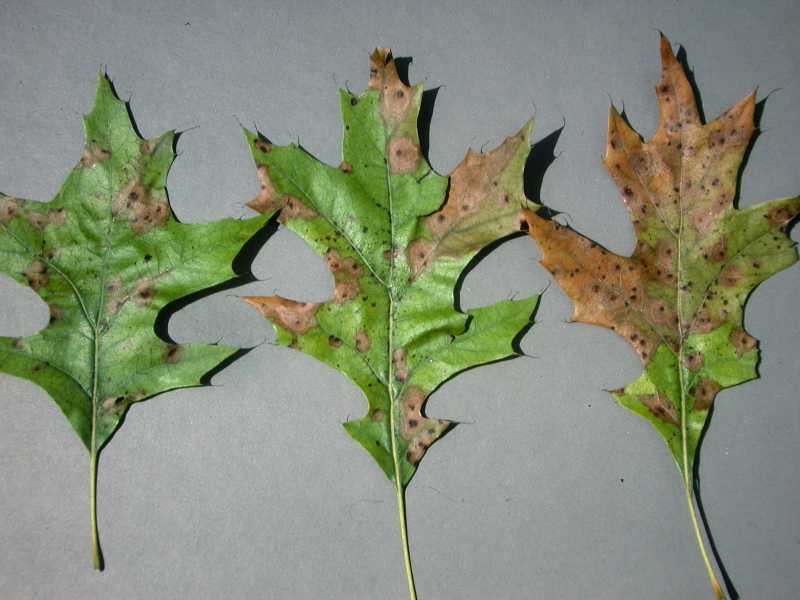 Leaf spots
Leaf spots |
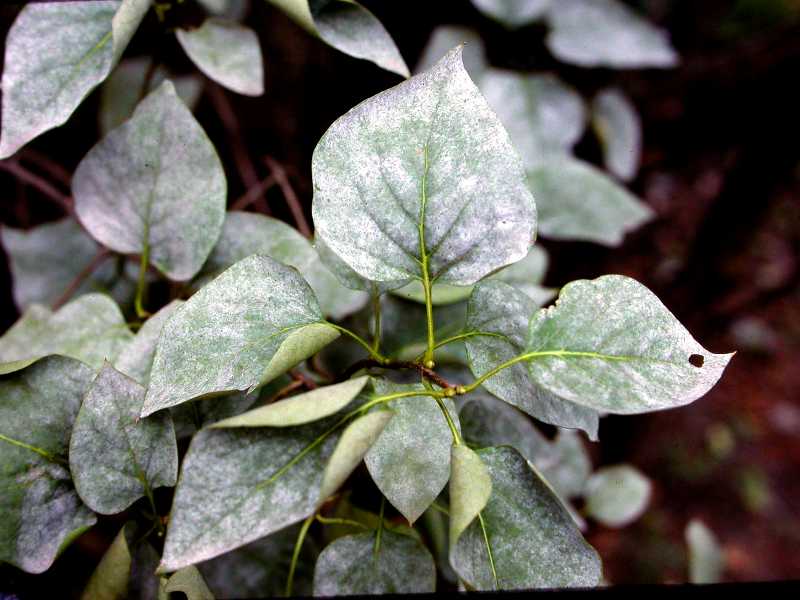 Powdery mildew
Powdery mildew
|
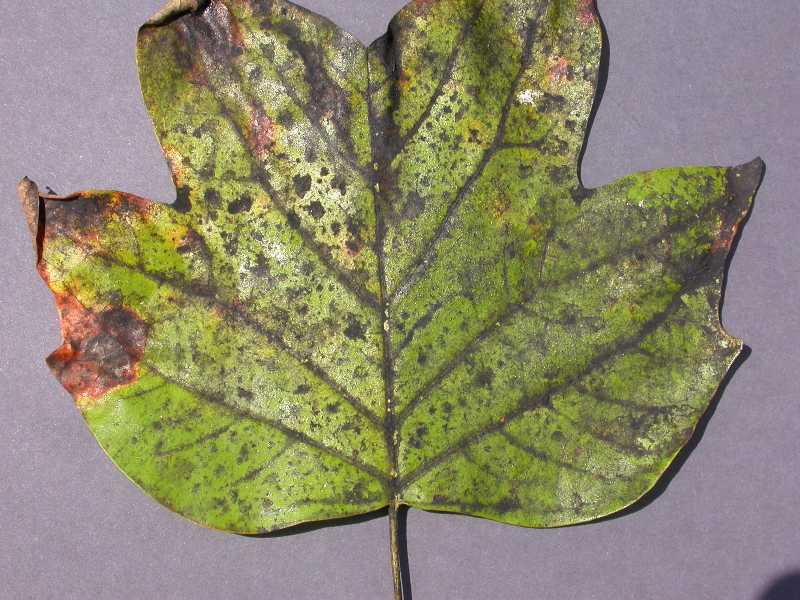 Black mildew & Sooty mold
Black mildew & Sooty mold
|
Spots on leaves can be caused by many factors including both biotic and abiotic. Many are of little concern as they do not endanger the health of the plants, but others can be serious.
See:
Anthracnose
Bacterial spots
Fungal spots
Needlecasts
Apple scab |
Powdery mildew is common on many plants. It is characterized by a thin layer of light colored powdery materials on leaf surfaces. It causes little if any damage on mature trees and shrubs but can weaken roses and young plants. If control is required, fungicide sprays can be used.
See:
Powdery mildew – outdoors
|
Sooty mold, usually black in color, can cover the entire canopy of a plant. It generally indicates the presence of piercing-sucking insects, such as aphids or scale.
See:
Black mildew & Sooty mold
|
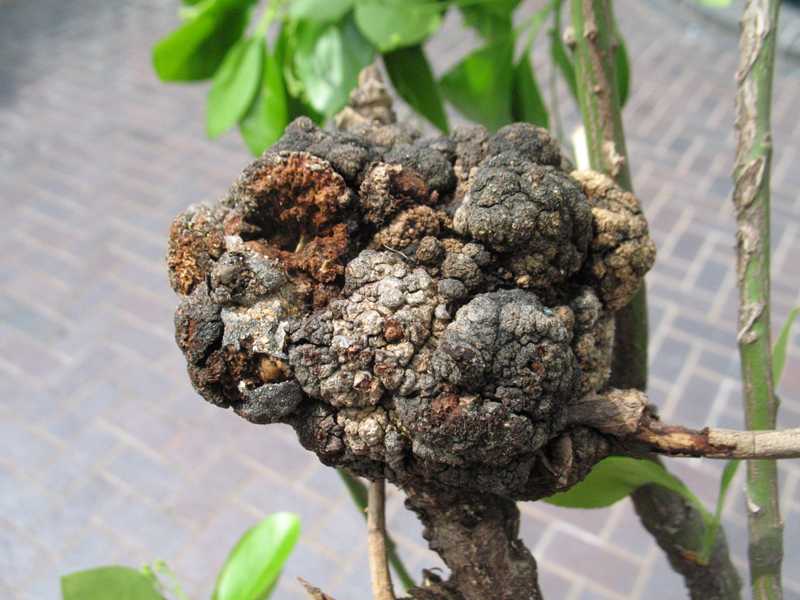 Galls
Galls |
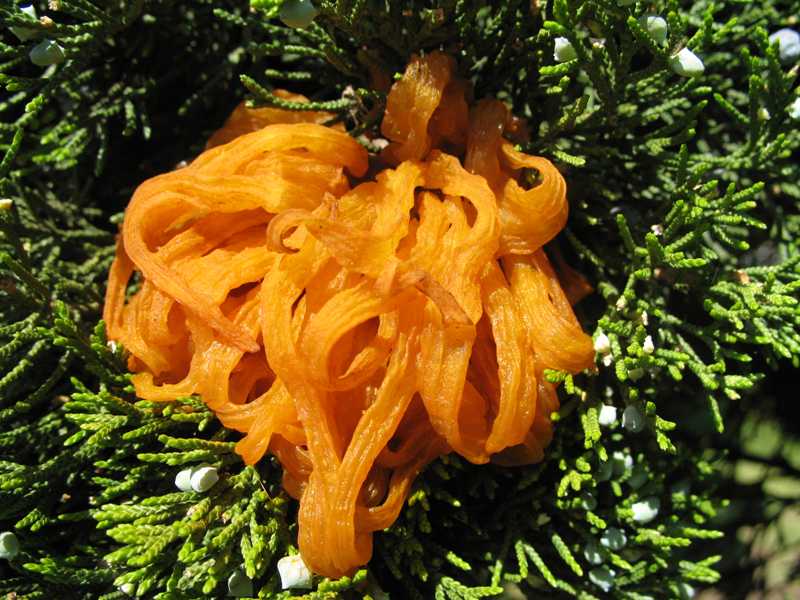 Rust
Rust |
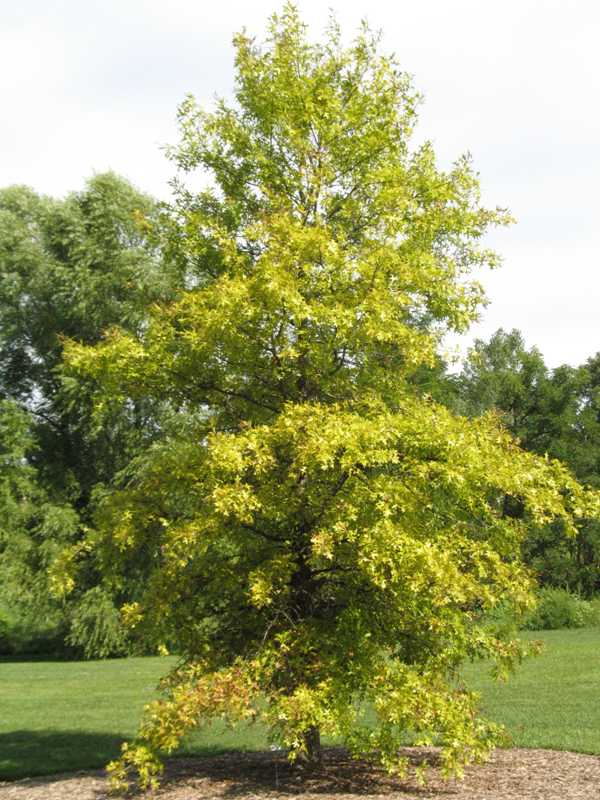 Iron chlorosis
Iron chlorosis |
In addition to galls mentioned in the insect section, some galls are also caused by bacteria or fungi. These also result in swelling and thickening structures on leaves, branches or trunks. Galls on stems are more serious than those that just affect leaves.
See:
Bacterial galls
Rust (see right)
|
Rusts result in powdery pustules of various colors on both leaves, bark and fruit of some plants. A rusty-orange color, hence the name, is very common. Most rusts have alternate hosts, e.g. cedar-apple rust.
See:
Rusts
|
Iron chlorosis, characterized by yellowing of new growth with veins remain green, is common on many plants that require an acid soil, such as azaleas and pin oaks.
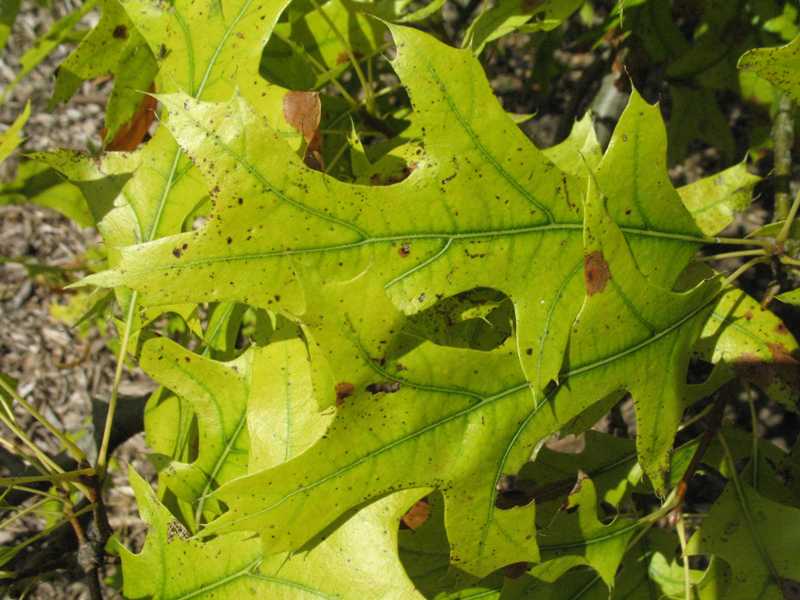
See:
Iron chlorosis |
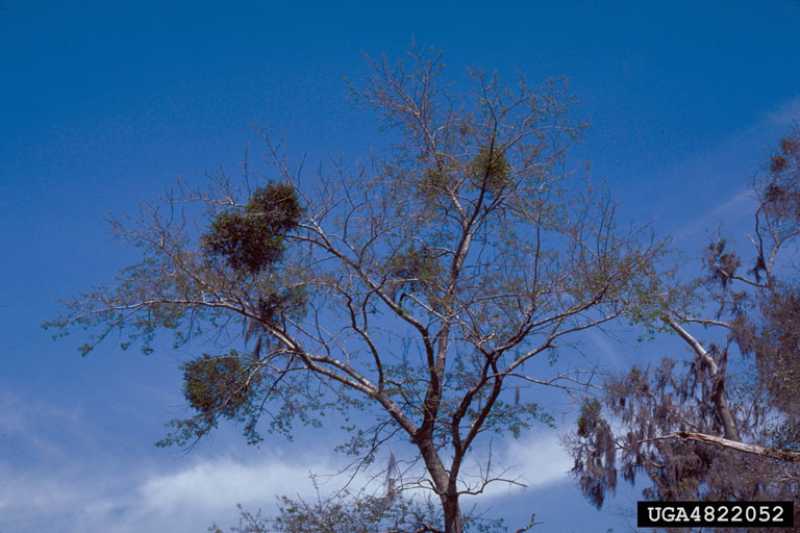 Mistletoe
Mistletoe |
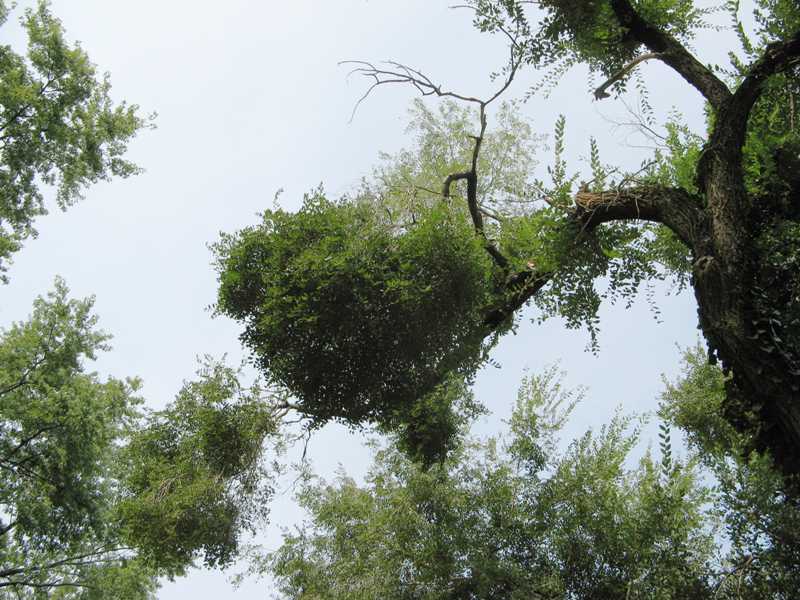 Witches' broom
Witches' broom
|
|
Mistletoes are parasitic plants growing on the limbs of other plants. Infected branches are usually swollen and may die back.
See:
Mistletoe
|
Witches’ brooms are clusters of small, weak twigs growing on branches. Some are caused by insects, others by disease. In some cases they are stable mutations and are the source of some dwarf plants, commonly dwarf conifers.
Removal by pruning is the most effective control method.
See:
Witches’ broom
|
|
| Environmental |
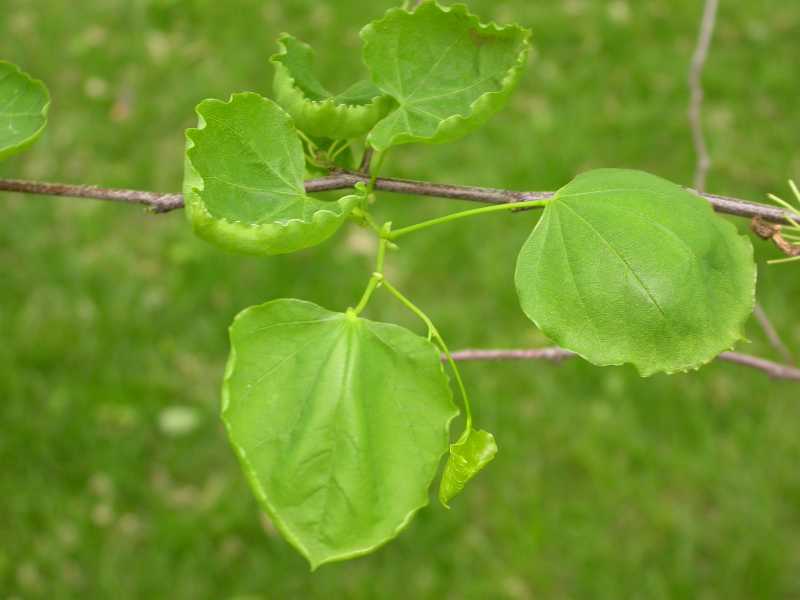 Herbicide damage
Herbicide damage |
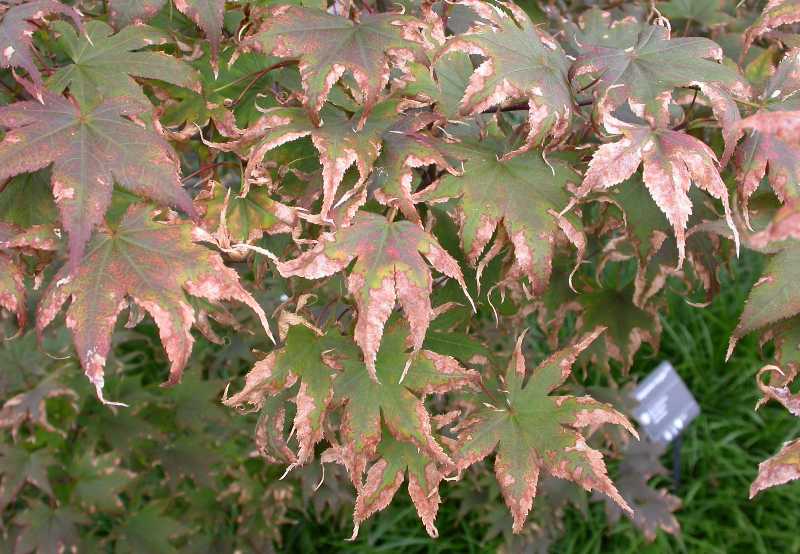 Scorch
Scorch |
 Air pollution & Others
Air pollution & Others |
Deformed or curled leaves and stems are often a sign of herbicide damage. This damage can result from herbicide overspray, volatilization of the herbicide or herbicide absorption by tree roots growing in an area where a granular weed killer was applied to the lawn or root area.
See:
Herbicide damage to plants
|
Scorch is common on many trees and shrubs especially during times of drought or when a shade-loving plant is receiving too much intense sun. It is often confused with a leaf disease but its distinctive pattern of being confined to the edges of leaves with browning between the veins makes it easier to diagnose correctly.
See:
Scorch, sunburn and heat stress
Scorch (bacterial)
|
Abnormal color of the leaves along with curling and defoliation can be a sign of air pollution. Ozone damage is common in many urban environments. Plants are usually not killed but foliage appearance can be reduced.
See:
Air pollution
Ozone damage to plants
Sulfur dioxide damage
Winter injury |
|
Leaves or Twigs - Webs, Bags or Rolled Leaves
|
| Insects |
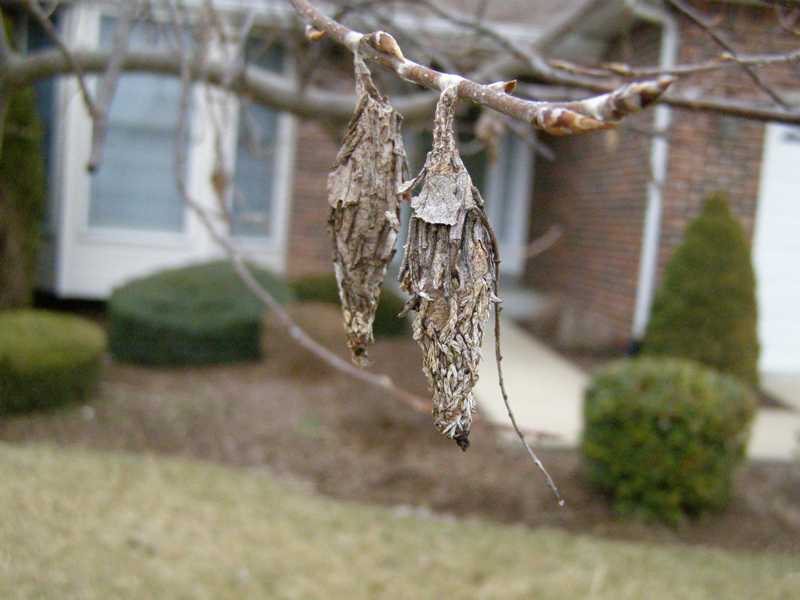 Bagworm
Bagworm |
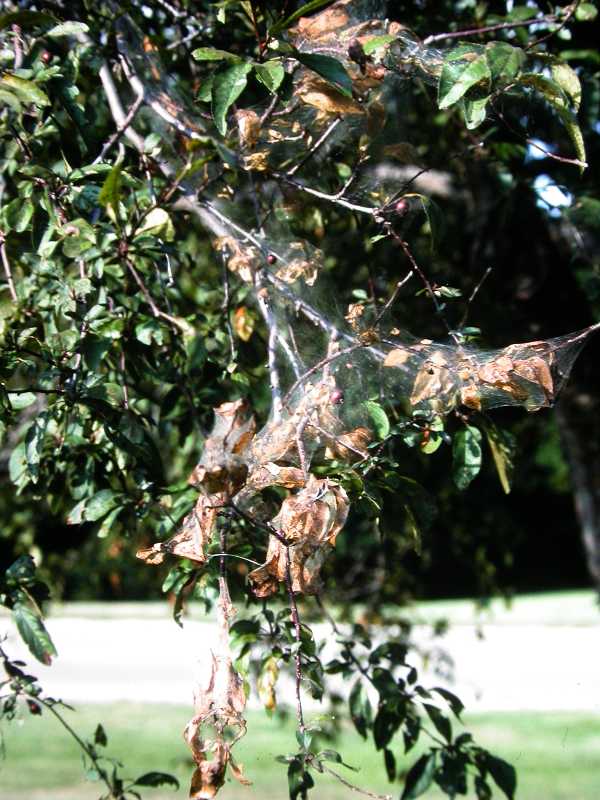 Tent caterpillar
Tent caterpillar |
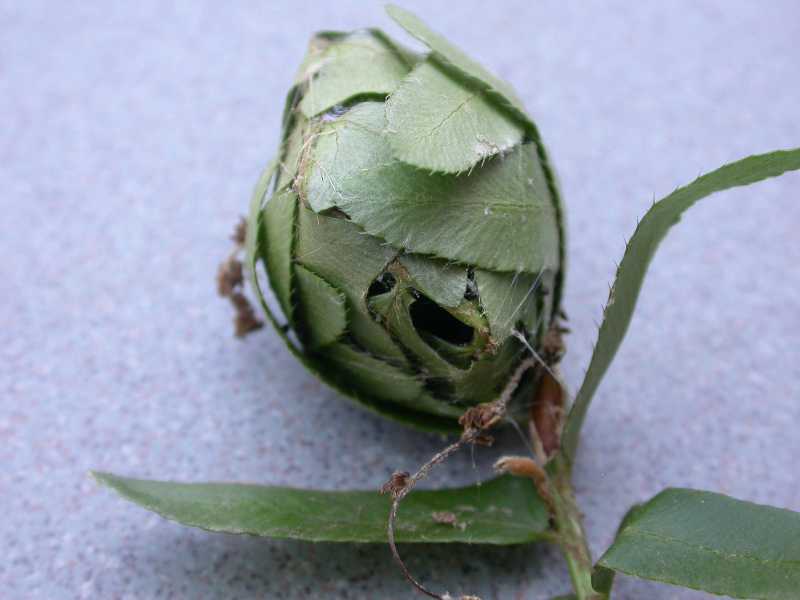 Caterpillar, leaf-rollers
Caterpillar, leaf-rollers |
Bagworms can be a serious problem on many evergreen conifers but also feed on deciduous trees and shrubs. Chewed needles and leaves or defoliation can be detected along with carrot-shaped cases hanging on the branches. Scout for and remove the bags manually from plants in winter to reduce insect populations.
See:
Bagworms
|
Silky nests along with leaf defoliation are the signs of either the tent caterpillar in spring or the fall webworm in summer or fall.
See:
Eastern tent caterpillar
Fall webworm
Forest tent caterpillar
Caterpillars – leaf tiers, bagworms & web formers
|
Several caterpillars use silken threads to form leaves into a home for shelter and to feed.
See:
Caterpillars – leaf tiers, bagworms & web formers
|
|
Twigs - Wilted, Dead or Deformed
|
| Insects |
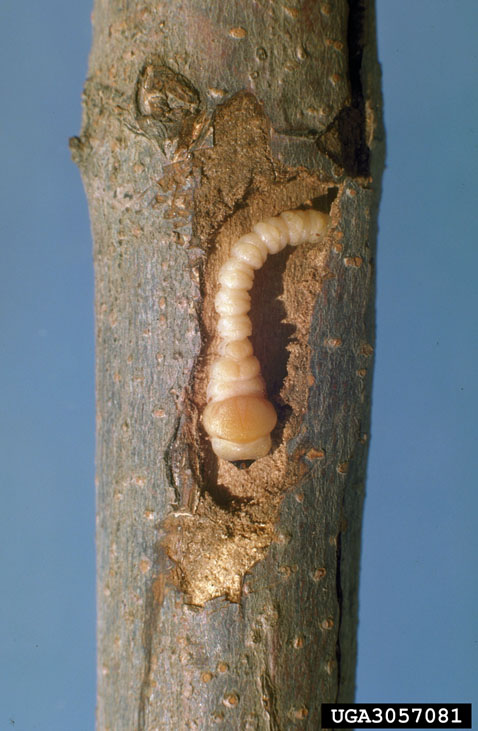 Borers
Borers |
 Twig girdlers & pruner
Twig girdlers & pruner |
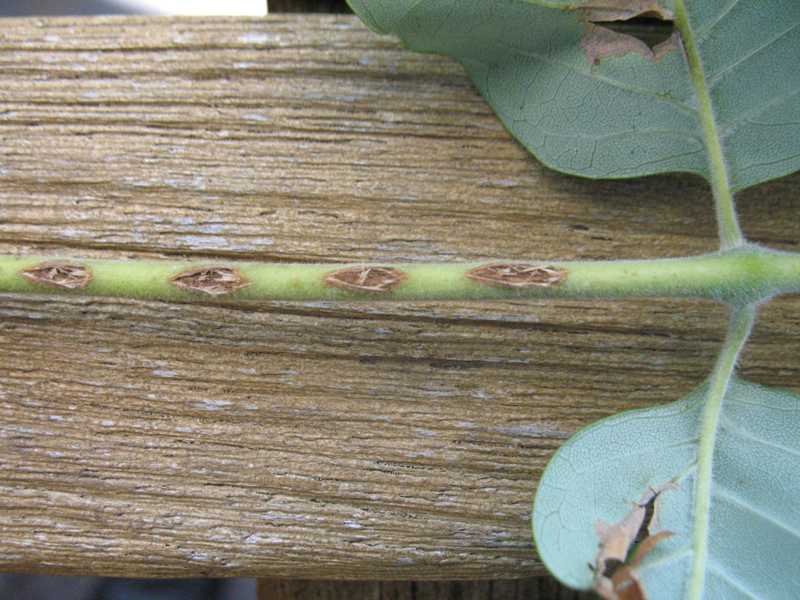 Cicadas
Cicadas |
Borers and miners are the larvae of various insects, particularly beetles, flies and moths. These larvae construct tunnels in terminal shoots, branches, trunks and roots of woody plants of all sizes. They can cause twigs to die and in severe cases cause the whole plant to decline. They are commonly concealed beneath the bark or in the wood, making them difficult to detect and control.
See:
Beetles - Borers and miners
Caterpillars - Borers and miners
Sawflies - Borers and Miners
Bark beetles (below)
|
Twig girdlers can cause death of young twigs (flagging) and when the twigs break off, dead twigs on the ground. Close examination is required to verify a twig girdling insect as the cause. They generally do little damage to a mature plant.
|
Cicadas are sizable, noisy insects. They emerge from the soil in mid to late summer, and spend much of their time thereafter in trees, where they molt and issue their sometimes startlingly loud mating calls. None cause serious damage to more mature trees though small trees, especially young orchard trees, may suffer significant damage on the underside of twigs and branches.
See:
Cicadas |
| Diseases and Disorders |
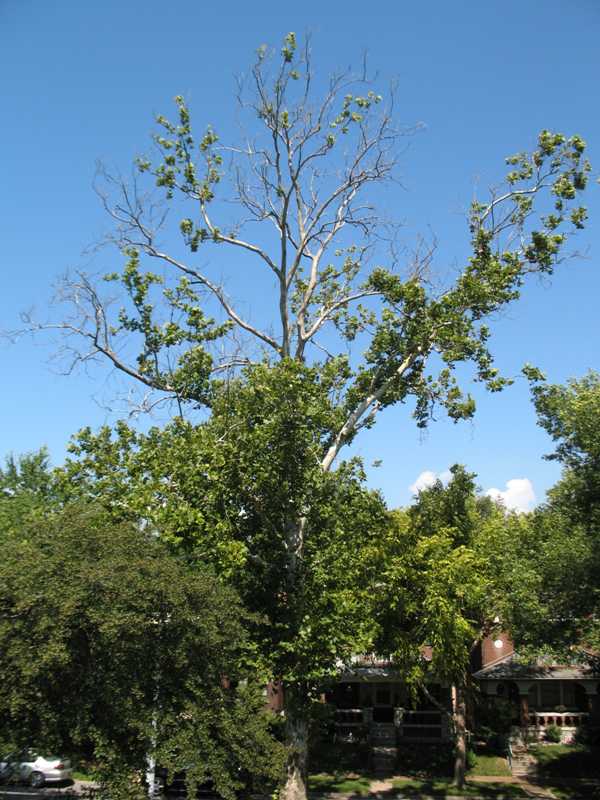 Tip dieback
Tip dieback |
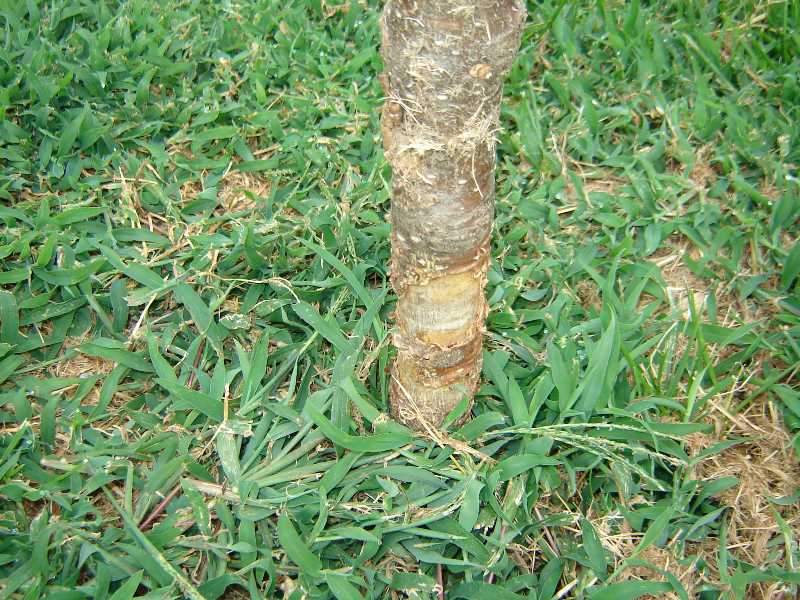 Other
Other |
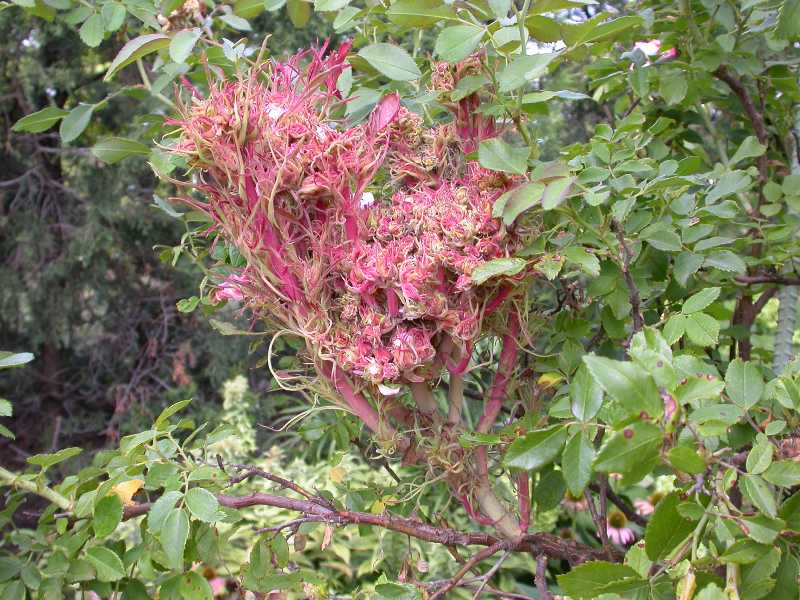 Viruses & Phytoplasmas
Viruses & Phytoplasmas |
|
|
Trunk or root problems can also result in tip and branch dieback.
See:
Problems on Trunks, Limbs or Whole Plant (below)
|
Deformed shoots of roses can be caused by rose rosette. Ash trees can get ash yellows.
See:
Rose rosette
Ash yellows
|
| Environmental |
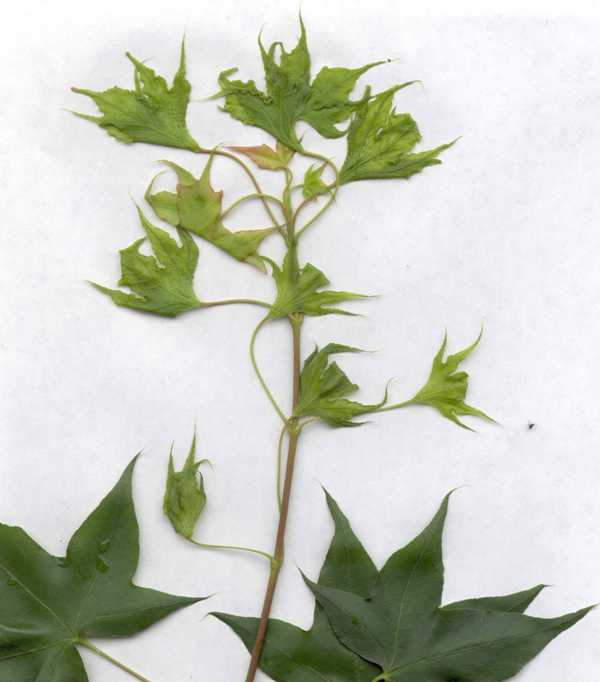 Herbicide damage
Herbicide damage |
 Winter injury/dieback
Winter injury/dieback |
Other
|
Deformed or curled leaves and stems are often a sign of herbicide damage. This damage can result from herbicide overspray, volatilization of the herbicide or herbicide absorption by tree roots growing in an area where a granular weed killer was applied to the lawn or root area.
See:
Herbicide damage to plants
|
Winter cold and desiccation can cause tip dieback, especially in broadleaf evergreens and tender plants.
See:
Winter injury
|
See:
Animals (below)
|
|
Problems of Trunks, Limbs or Whole Plant
|
| Insects |
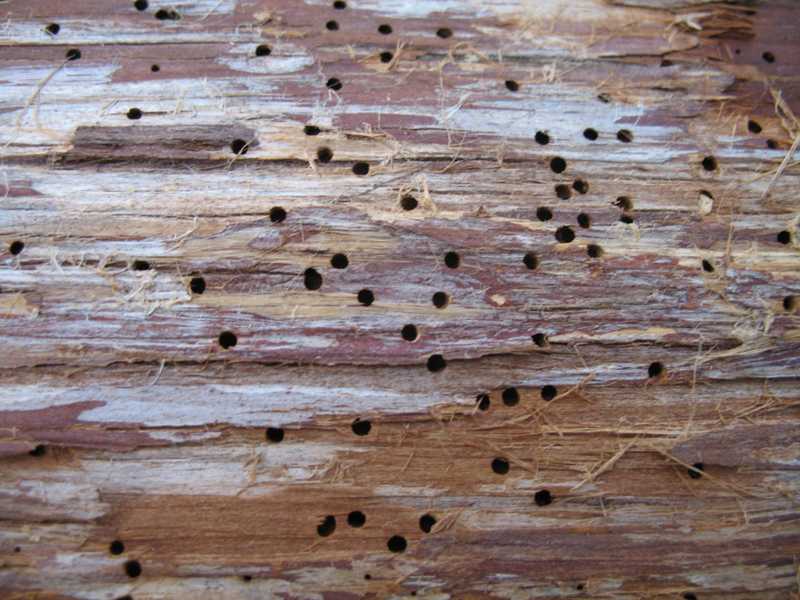 Holes -
Holes -
Bark beetles |
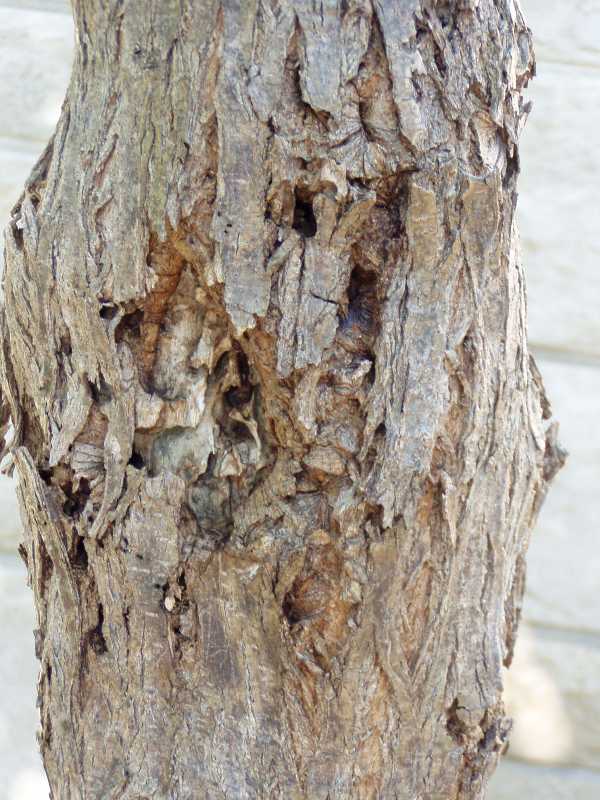 Holes -
Holes -
Borers |
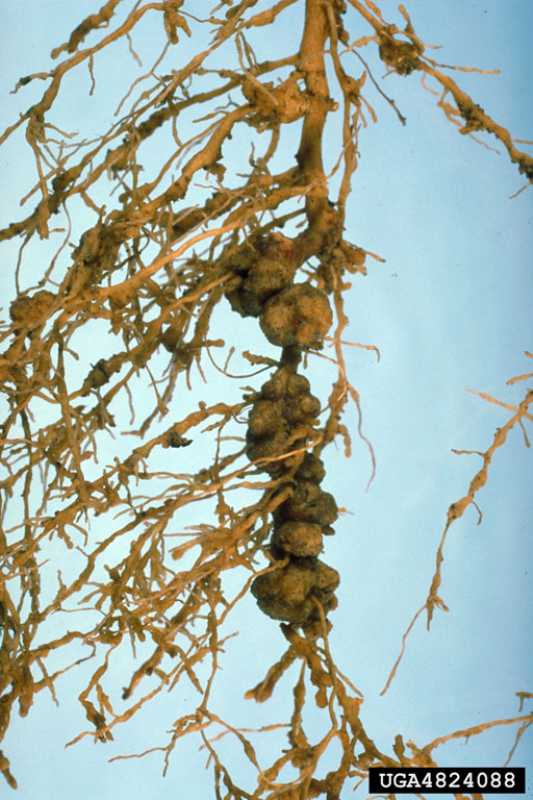 Root insects and
Root insects and
Nematodes |
Bark beetles are commonly seen on weakened or dead conifers and other woody plants. They are only 1/16 to ¼ inch long and tunnel in the wood just below the bark. Adults leave small exit holes in the bark when they emerge. Dead, sloughing bark on dead branches reveal the tunnels below.
See:
Bark beetles |
Most wood boring beetles attack weakened, damaged, dying or dead plants. Some also attack healthy trees and shrubs. Because the insects bore inside the twig, stem or trunk they can go unnoticed until dead twigs or patches of loose bark are noticed. Early warning signs can be holes with sawdust-like frass coming from them. Serious damage or death of the plant can be the result.
See:
Beetles – borers and miners
Caterpillars – borers and miners
Sawflies – borers and miners
Emerald ash borer
|
Insects in the soil feeding on plant roots can be very difficult to diagnose. On trees and shrubs inspection of the roots is all but impossible until the plant dies and is removed. Then, the cause of the plant’s decline may become clear.
See:
Beetles – grubs
Root-feeding weevil larvae
Phylloxeras
Nematodes |
| Diseases and Disorders |
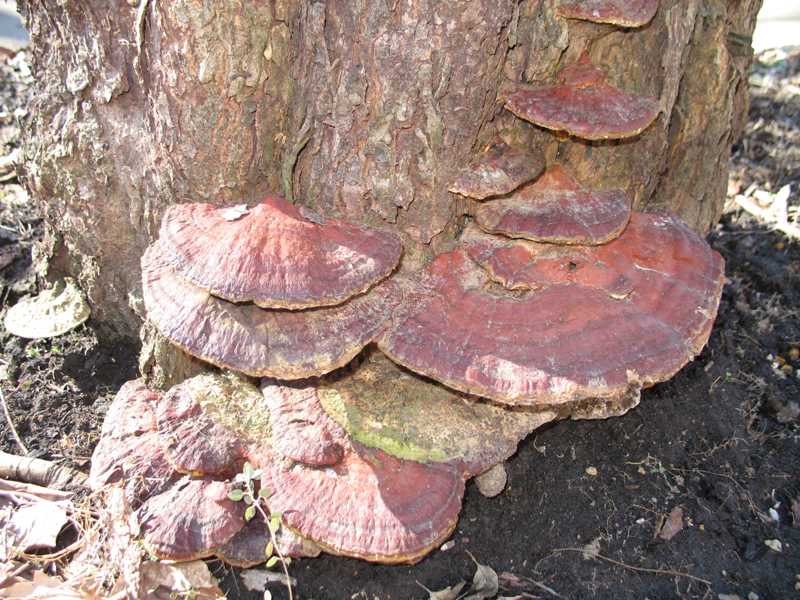 Conks
Conks |
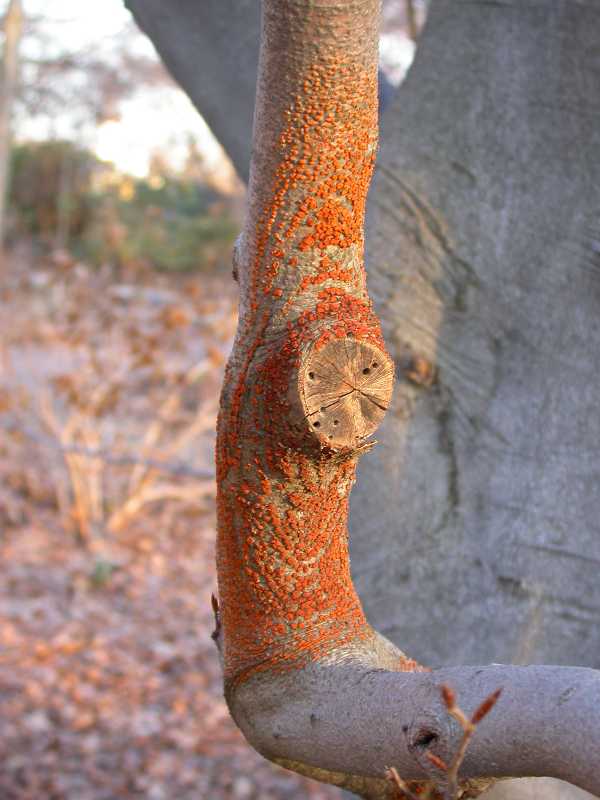 Cankers
Cankers |
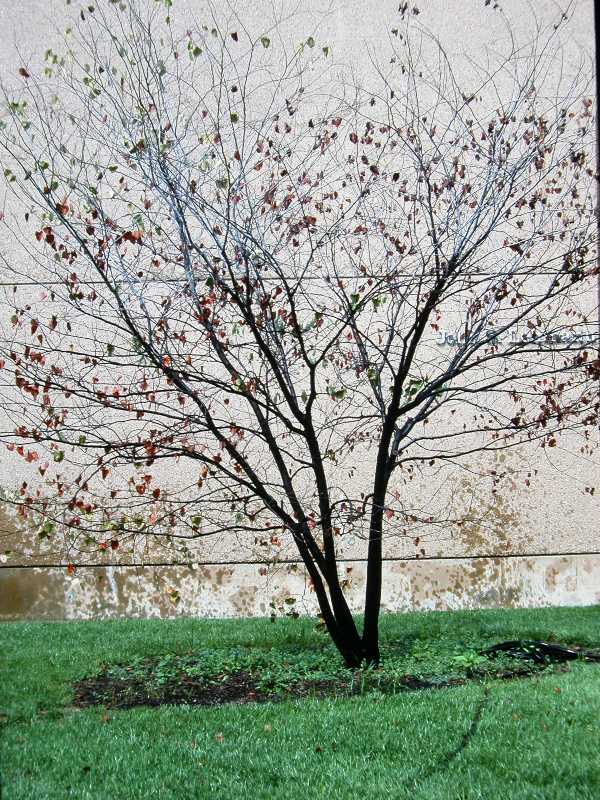 Wilts & Declines
Wilts & Declines |
Conks are mushroom (fungal) fruiting bodies associated with internal decay of woody stems and trunks. Trees with conks or mushrooms should be evaluated by an arborist to determine the extent of internal rot and the safety of the tree.
See:
Root, stem, crown & collar rots |
Cankers are serious fungal diseases that result in dark-colored, dead and sunken areas on trunks and/or branches. Sticky, amber-colored sap may ooze from the cankers. Infected plants may suffer yellowing leaves, defoliation and dieback.
See:
Cankers, diebacks & wilts |
Wilts and declines can be caused by many factors. Extensive investigation, and in many cases laboratory culture, may be necessary to positively diagnose wilts or declines that are the result of fungi, bacteria or viruses. Improper cultural care is also a very common cause.
See:
Cankers, diebacks & wilts
Viruses & phytoplasmas |
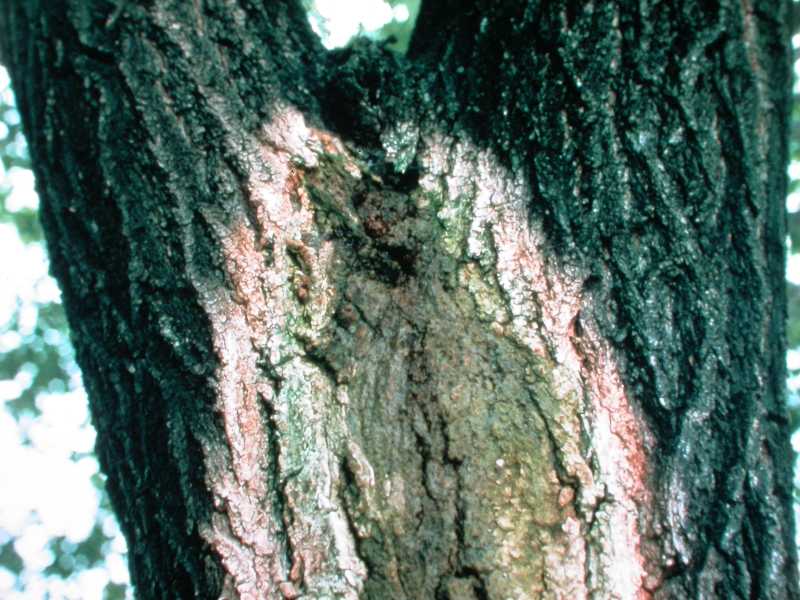 Slime flux
Slime flux |
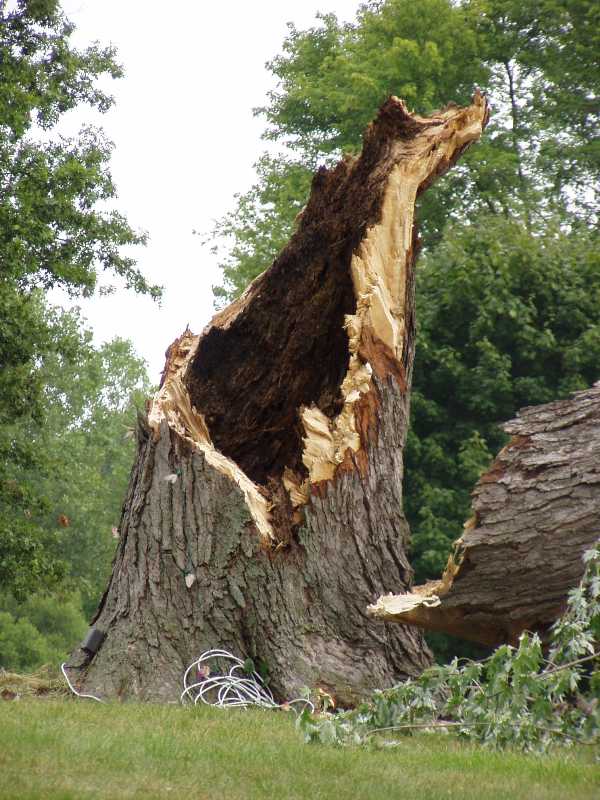 Holes - Internal decay
Holes - Internal decay |
|
Slime flux is a sour-smelling ooze that flows from open wounds on trunks or branches. Typically, it results from an internal bacterial infection that causes internal pressure.
An arborist should be contacted to evaluate the situation and make recommendations as to whether treatment is possible or if you should just live with the problem.
See:
Bacterial wetwood
|
Internal rots and trunk decay are serious conditions that weaken the trunk, branches and roots. They can make a tree or branch hazardous. They usually develop slowly from wounds and in time can hollow out a trunk or branch causing it to fail. Dead branches, peeling bark and a hollow sound when a tree trunk is thumped can all be signs of internal decay. These require a professional evaluation. |
|
| Environmental |
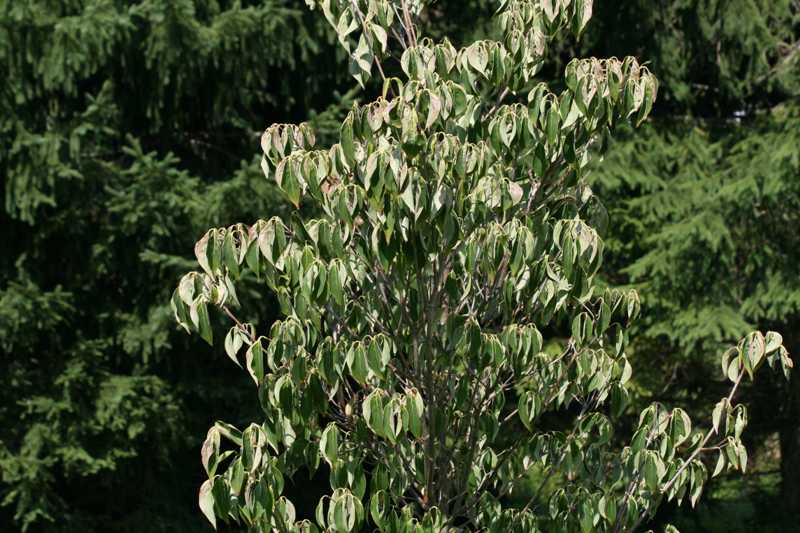 Transplanting
Transplanting
shock |
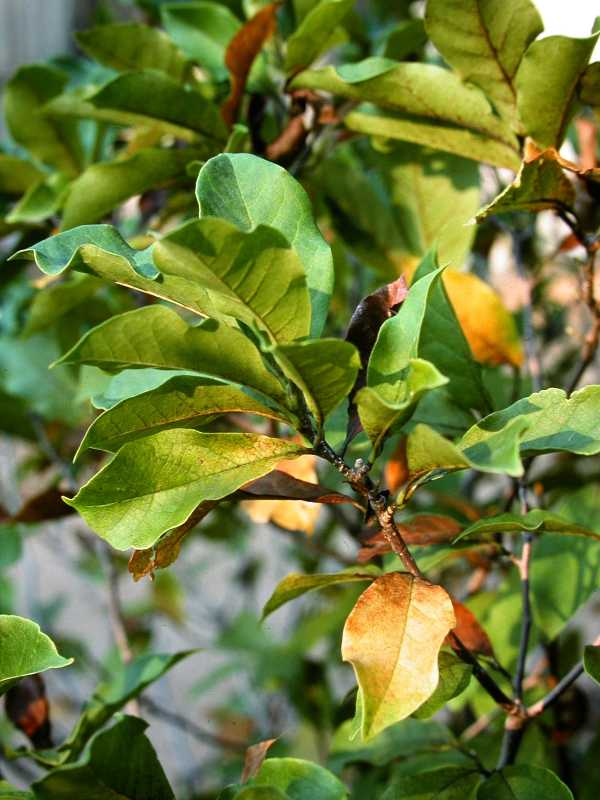 Underwatering & Drought
Underwatering & Drought |
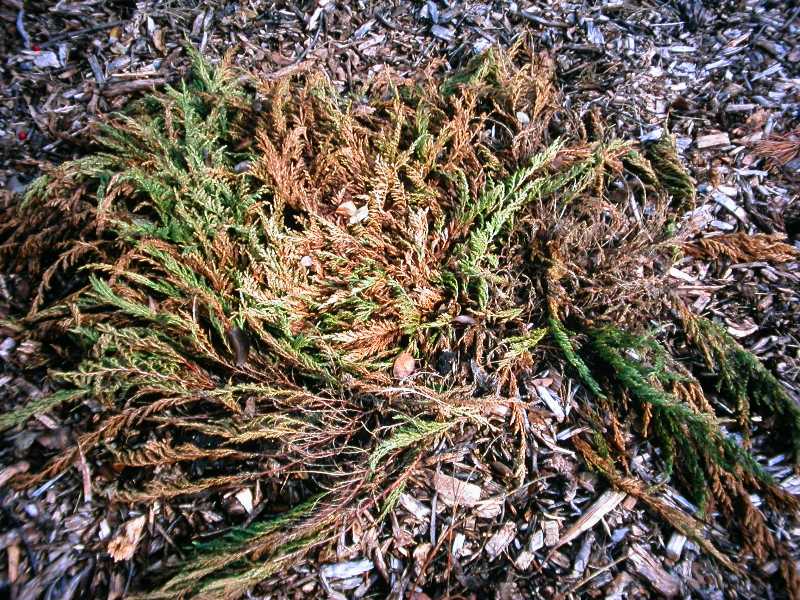 Overwatering / Poor drainage
Overwatering / Poor drainage |
Newly planted trees and shrubs need frequent monitoring. After transplanting, some plants may experience frequent wilting. Even if the soil is wet, the roots may not be capable of absorbing water and nutrients. Getting the right balance of soil moisture can be challenging.
See:
Failure to establish
Sudden decline
Gradual decline
Improper and damaging garden practices |
Most trees and shrubs need consistent moisture on a regular basis. Lack of water can result in very quick wilting, browning and dying or can put a plant into decline. The full effects of drought may not be seen for a number of years. Monitor plants closely during hot, dry summers and don’t neglect plants, especially needled and broadleaf evergreens, in fall and winter when they still need water.
See:
Drought and water stress
Salt injury |
Plants need water but too much water can also lead to damage.. Overwatering or poor drainage can lead to chlorosis, defoliation and root rots. In severe cases a plant may die rapidly from root rot. In less severe cases, leaves may yellow, plants may wilt and/or the edges of leaves may turn brown. For soils that drain poorly, select plants that can tolerate these soil conditions. Check and monitor irrigation systems to make sure they are not keeping any areas too wet.
See:
Overwatering
Improper and damaging garden practices |
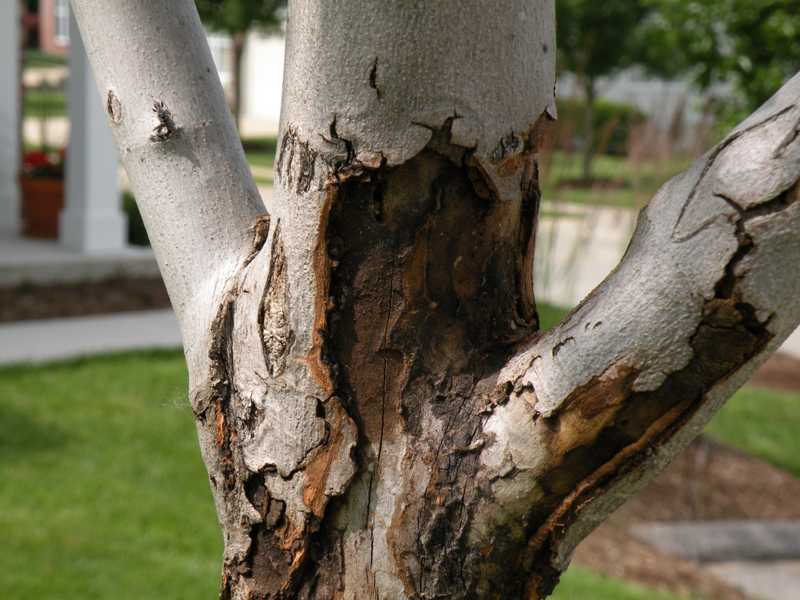 Sunscald
Sunscald |
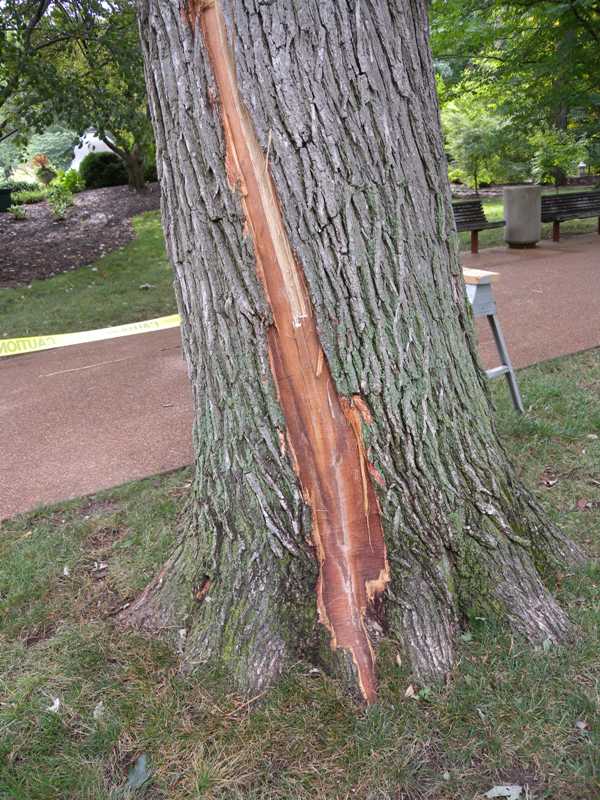 Lightning damage
Lightning damage |
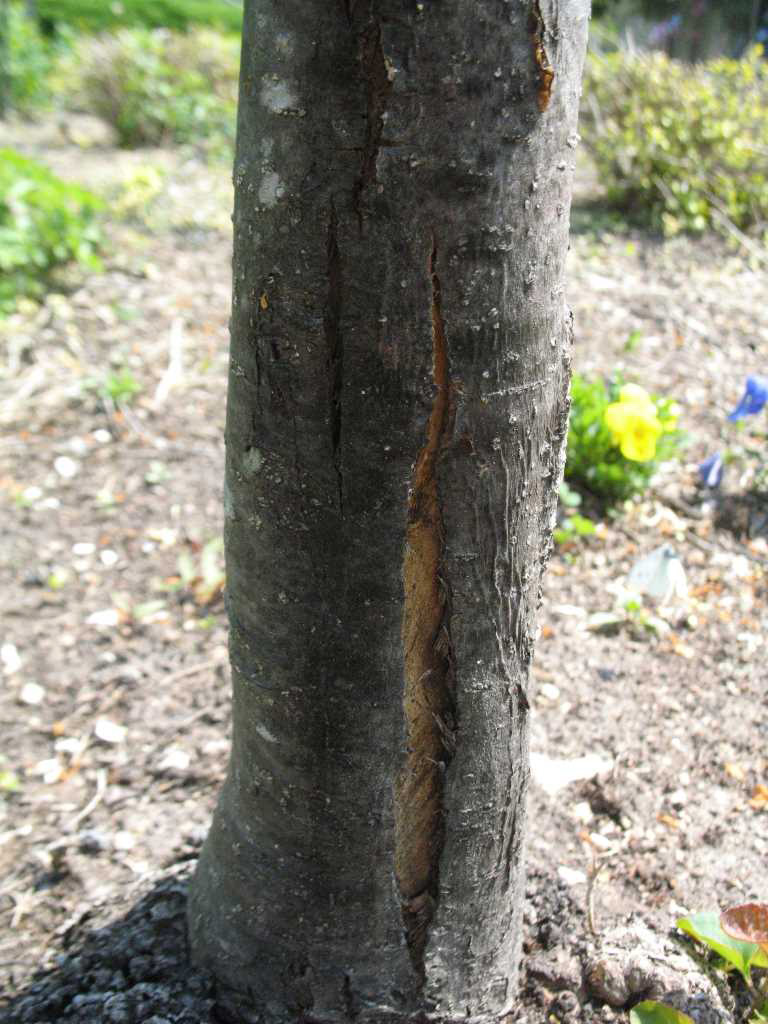 Frost cracks
Frost cracks |
Sunscald occurs when bark on the southwest side of a tree, which is exposed to the warmth of the sun, is killed. This can occur in winter when bark comes out of dormancy followed by freezing temperatures that kill the bark. Intense sunlight in summer can also heat and kill patches of bark. The damage may not be noticed for several years until the bark cracks and begins to peel off.
See:
Sunscald |
Damage from lightning can be mild or severe. In severe cases, parts of the tree or bark may be blown off the tree. This could be followed by partial to complete browning and death to the tree. Dangerous trees should be removed by an arborist but in mild cases one may want to wait and see how the tree reacts. In mild strikes the tree may recover with not much noticeable damage. Installation of lightning conductors can prevent further injury.
See:
Lightning injury |
Frost cracks are vertical crack in the bark caused by rapidly changing temperatures in winter. In most cases they heal over and are not damaging to the tree. Deep cracks may require examination by an arborist.
See:
Frost cracks
|
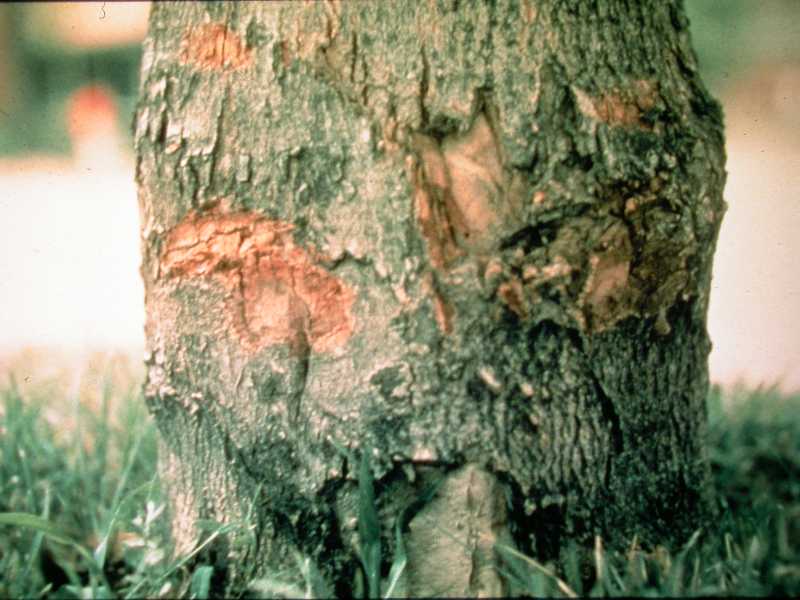 Mechanical damage
Mechanical damage |
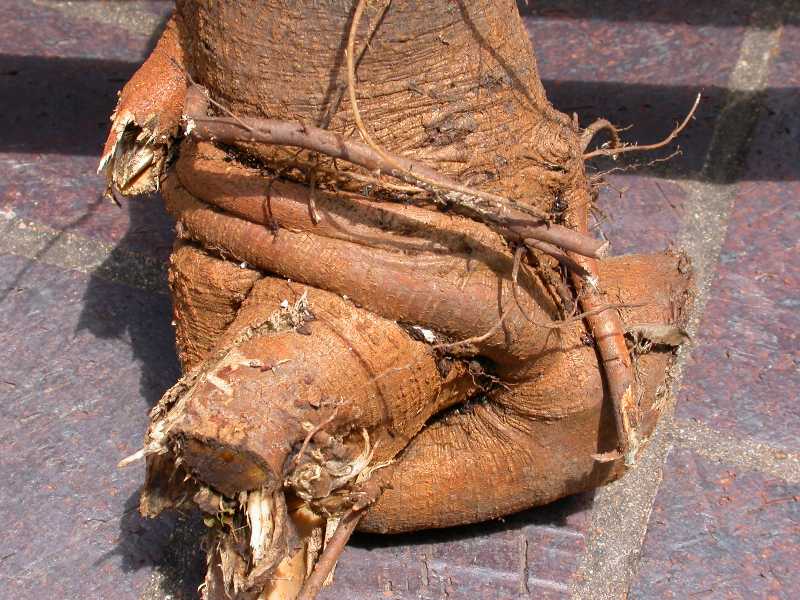 Girdling roots
Girdling roots |
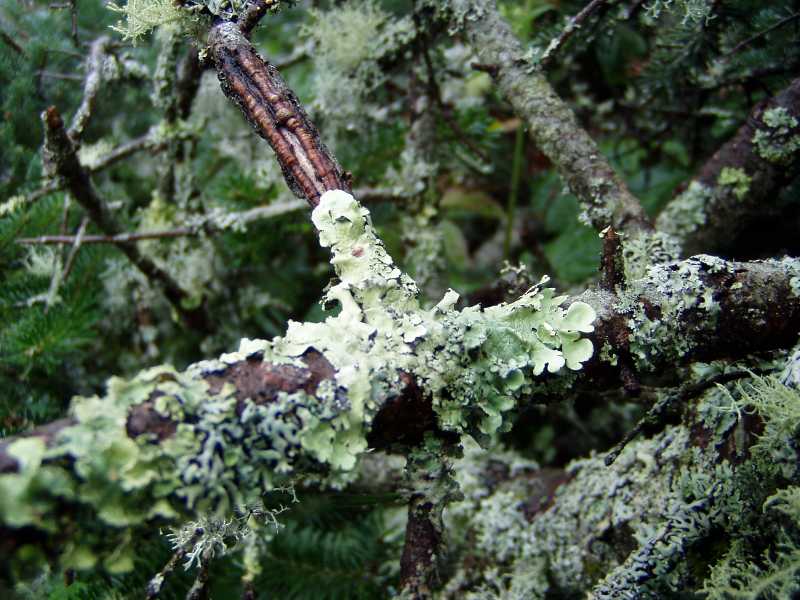 Lichens
Lichens |
Lawn mowers and weed whips can cause considerable damage to trees by creating wounds at the base of plants. In severe cases the plant may be completely girdled. Examine the base of plants for any signs of damage. Hand-pull any weeds close to the trunk. Never use a weed whip around tree trunks and don’t bump the trunk with a lawn mower.
See:
Mechanical damage
Improper and damaging garden practices |
Girdling roots are roots that circle the trunk of a tree or shrub. In time they cut off the movement of nutrients in the trunk. They can result in the death or failure of a tree. Girdling roots may be visible on the surface of the ground or hidden below ground. Symptoms can be general such as shrinking leaves, defoliation and branch dieback. A general health decline may occur as well.
Most often when symptoms are noticed it may be too late to correct the problem or the problem may be underground where it is only revealed when the plant dies and is removed.
See:
Girdling roots
|
Lichens are crusty, soft, leaf-like structure of various colors that develop on shady trunks or branches under high humid condition. They are not damaging to the tree. They are a part of nature and do not have to be removed.
See:
Miscellaneous
Normal |
|
Animals
|
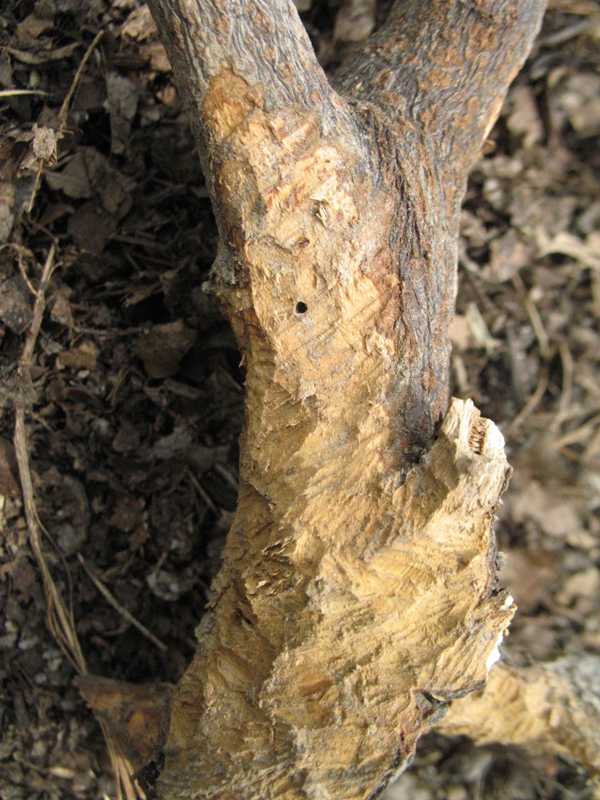 Voles and Mice
Voles and Mice |
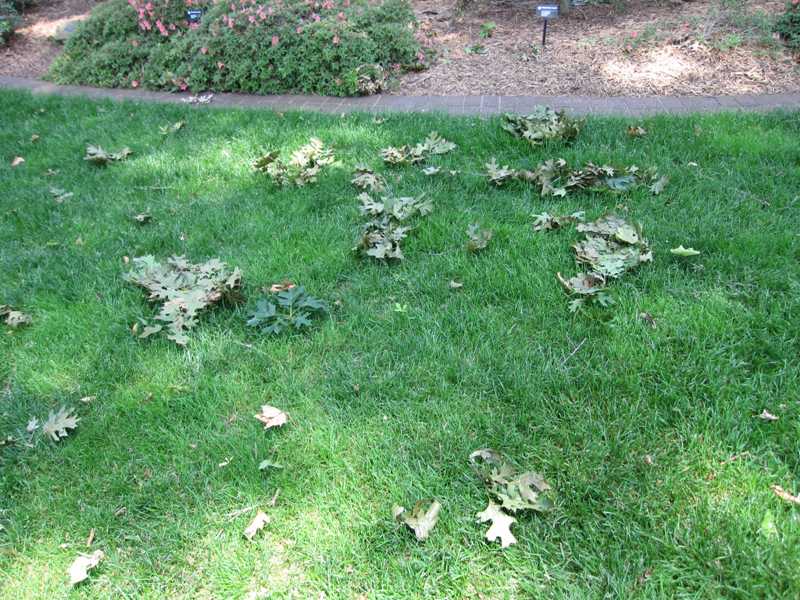 Squirrels
Squirrels |
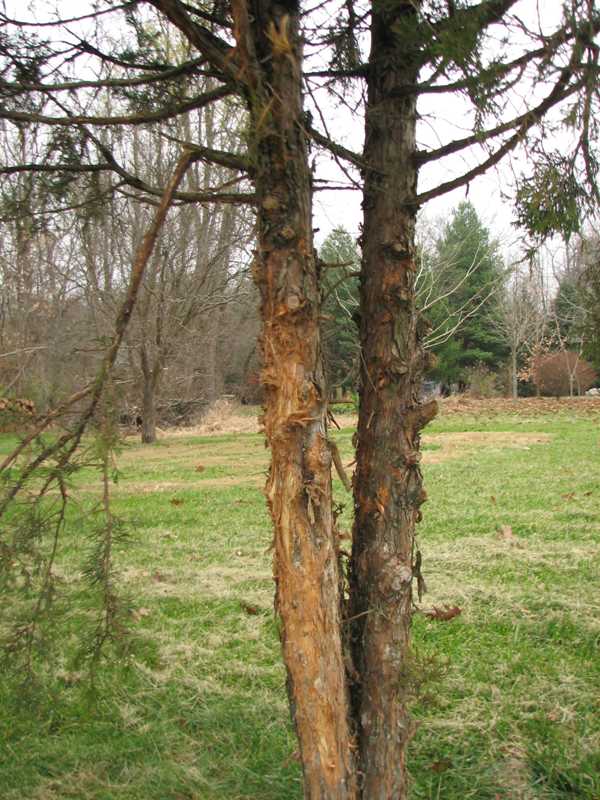 Deer
Deer |
Mice can cause significant winter damage to small trees and shrubs (especially fruit trees) by chewing bark at the base of the tree. Discourage mice from overwintering in mulch or grass at the base of trees and provide barriers or guards if needed. Repellents can also be used.
See:
Voles and Mice |
Squirrels can cause damage to trees in mainly two ways. One, they chew off short twigs to use for their nests. This is not usually a problem to the tree but when they drop a twig and it falls to the ground, it can cause a gardener concern. Two, on occasion they will claw and strip bark from branches and limbs. Depending upon how much bark is damaged it could be minor or more damaging. Remove any loose bark and keep the damaged area clean and dry. The bark may heal over.
See:
Squirrels |
Deer can be devastating to trees and shrubs. Small plants that are palatable to deer can suffer severe browsing damage. Leaves and branches appear ripped from the plant.
Protection is needed. Also, in the fall male deer can severely damage the trunk of small to medium size trees as they rub their antlers on the tree trunk. The result can be considerable bark loss or damage. Protect the trunks of young trees.
See:
Deer |
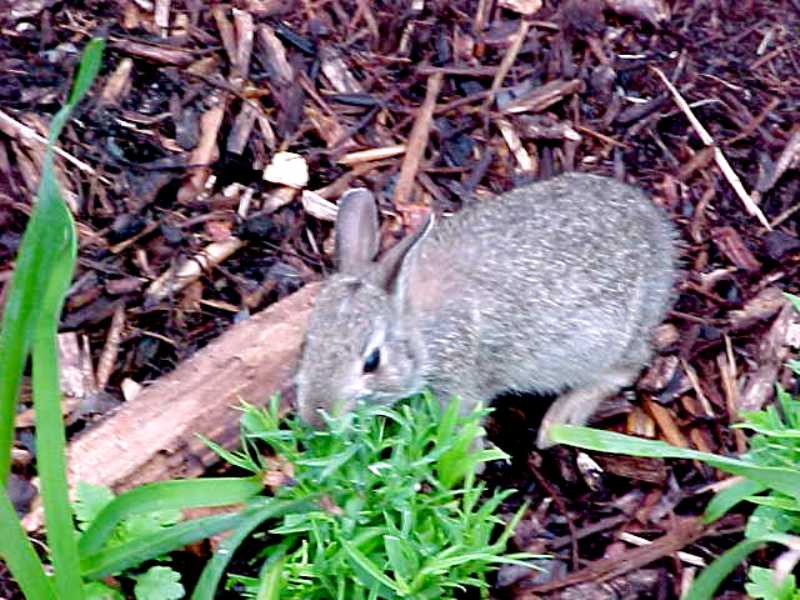 Rabbits
Rabbits |
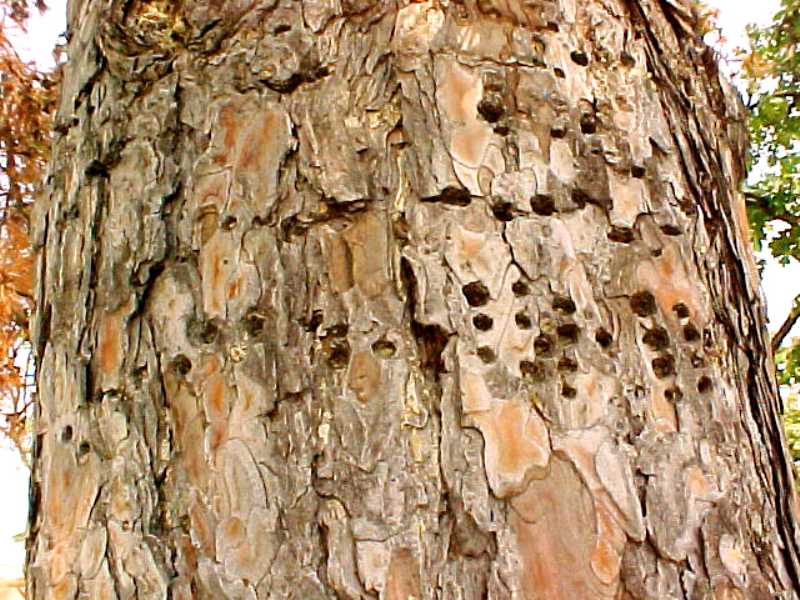 Birds - sapsuckers
Birds - sapsuckers |
|
Rabbits can be damaging for young trees and shrubs but usually are of little concern for more mature plants. Protect young plants from browsing rabbits when the plants are small and vulnerable.
See:
Rabbits |
Birds normally bring far more benefits than grief to gardeners because they eat large numbers of insects. However, the yellow-bellied sapsucker, may harm trees by feeding on plant sap and opening wounds were insects or disease can enter.
See:
Nuisance birds |
|